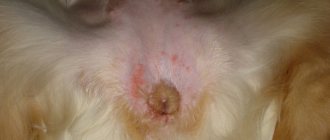Sexual heat, which changes the behavior of an obedient pet beyond recognition, is not only a test of strength for the owner, but also a possible threat to health. If the animal is not involved in breeding, then veterinarians recommend surgery to remove the reproductive organs. Thanks to it, you can get rid of persistent male dogs and accidental pregnancies, as well as prevent the development of oncology.
Despite the benefits described, it is still possible to experience bleeding after surgery. It remains only to understand whether a sterilized dog can be in heat or whether the observed symptom is a sign of a more serious problem.
Consequences of surgery
Sterilization involves tubal ligation, which makes it impossible to conceive.
At the same time, the sexual cycle and its signs remain the same. Estrus (empty period) will proceed as before. The bitch will retain her sexual instinct and will strive to mate at certain times. Bloody discharge will appear from the genital loop. Castration is an operation in which the ovaries and sometimes the uterus are removed. This procedure provides for the complete cessation of estrus with its signs. Pregnancy after castration is impossible. There are cases when the ovarian function is performed by the adrenal glands. The sex hormone produced by the adrenal glands can again cause estrus. The case is rare and depends on the characteristics of the dog’s body. When heat returns, the animal must be shown to a veterinarian.
Removal of reproductive system organs involves:
Take the Attention Test! Find 10 differences! (click right here!)
Find the answer Are you bothered by some problem or question? Enter “Breed” or “Name of the problem” into the form, press Enter and you will find out everything about the issue that interests you.
- Stable behavior;
- No discharge;
- Sexual calm;
- Exception of pregnancy;
- Prevention of diseases.
A neutered dog is not subject to mood swings. She becomes calm and balanced.
The heat stops coming. Bloody discharge will not appear. The pet will no longer stain floors, carpets, or furniture with them. Maintenance efforts will be reduced.
The pet will not be subject to sexual estrus. Will not show aggression or increased interest in other dogs.
The operation prevents conception. The dog will not produce unnecessary offspring.
Removing reproductive organs reduces the risk of cancer. Eliminates the appearance of inflammatory processes in the uterus and ovaries.
Surgery for:
- Animals not intended for breeding;
- Yard and stray dogs;
- Dogs with genetic disorders;
- Pets with diseases of the genitourinary system.
It is advisable to spay or neuter animals that cannot produce healthy offspring. For example, bitches with thyroid disease are excluded from breeding. Hormonal imbalance will not allow them to bear and give birth to healthy babies.
Sterilization of stray dogs is practiced. So that they do not produce puppies with poor health.
A female or male dog with genetic abnormalities must undergo surgery. Breeding of such animals by dog breeders is excluded.
Sometimes, surgery has to be performed on sick animals. For example, for bitches in constant heat.
According to statistics, the cycle of castrated bitches lasts longer and is more carefree.
Actions of the veterinarian
Unfortunately, not all identified causes are subject to elimination and drug correction. The usual response from owners of dogs that are in heat after sterilization is:
- Estrus due to inertia is excluded by assessing the period of time that has passed since the operation and the level of sex hormones in the blood.
- An ultrasound can be done to monitor the removal of the ovaries. But this diagnostic method is not suitable for small breeds of dogs - you need either an ultrasound diagnostic doctor of the highest category, or a serious and modern ultrasound machine with an increased field of view. Otherwise, identifying ovaries in small individuals is almost impossible. A reminiscent ovary and ectopia cannot be seen at all on an ultrasound under any conditions.
- Taking tests to identify possible tumor processes in the body.
- Determination of estradiol and progesterone levels in the blood without additional medication.
- Conducting hormonal tests, when blood is taken at rest and after stimulation with special drugs that affect sex hormones under certain circumstances. Assessing the difference. By the difference in levels, one can judge the presence of glandular tissue in the body, which can produce hormones - whether it is present or not. Alas, using these tests it is impossible to determine where exactly the ectopia is located if this has been confirmed by tests. This category of tests includes tests with gonadotropin, gonadotropin-releasing hormone and luteinizing hormone.
- AMH test. Determines the presence of anti-Müllerian hormone in the blood, which can be used to determine whether sex hormones are secreted by reproductive organs or backup organs (adrenal glands, for example, or the hypothalamus). If the results show the presence of this hormone, then we are talking about ectopia or a residual ovary. Only the gonads produce it. If there is sexual activity, but there is no anti-Mullerian hormone, then the problem is different.
- Repeated surgery and additional removal of the remaining parts of the ovaries.
- Attempts to search for ectopia. These operations are performed very, very rarely. Ectopic ovarian tissue can be located anywhere inside. If the area is large, then a surgeon with extensive practical experience can try to look for it by literally searching through all the internal organs using a cavity approach. But it could be several cells - it is impossible for anyone to find them.
- Performing surgery to remove hormone-producing tumors.
- Medicinal corrections for hormonal duplication - “disconnection” from the reproductive cycles of organs that are not related to the reproductive system.
- If repeated operations are not possible, drug hormonal therapy is prescribed to correct the condition.
It is highly not advisable to give dogs any hormonal medications without consulting a specialist - there are side effects!
The procedure is set out in the order in which all medical diagnostic and therapeutic measures are usually carried out. But if at first the dog was observed in one place, and then the doctor was changed, but all the current test results of the animal are in hand, some points may be omitted.
Recovery period
The doctor performs the operation under anesthesia. It is difficult for a pet to recover after surgery. Anesthesia lasts from 2 to 12 hours. While the dog is unconscious, it must be regularly turned over to the other side. The recovery period depends on the physical characteristics of the animal.
The surgical suture requires daily treatment with an antiseptic. You will have to look after him for about a week or longer. Do not allow the animal to lick or scratch the seam. Your pet will have to wear a veterinary blanket. If after a week the seam is wet and red, take your pet to a veterinary clinic for examination.
After 3 days the dog's appetite should return. If your pet refuses food for more than five days, visit a veterinarian.
After recovery, you need to reconsider your diet. Dogs that have undergone surgery are prone to gaining excess weight. Moderate physical activity is beneficial for spayed and neutered dogs.
When is the best time to sterilize a dog?
Another myth is the fact that castration is done at an early age. This is not true in all cases. The operation is performed at any age. Also, an animal does not have to bear offspring even once
, as some say. Usually the operation is performed before the first heat, this serves as an excellent prevention of many diseases. After all, there is not a single case of a dog getting sick, for example, with mammary cancer after sterilization before the first heat.
If the animal is already aged, then the operation is more complicated with preparation before. It is necessary to do certain tests and studies, perform an ECG on the dog and other actions so that the effects of anesthesia are minimal and the operation is successful.
Such decisions and examinations should be coordinated only with experienced veterinarians. Only the best specialists work in our veterinary clinic. With the service of calling a doctor to your home, the owner saves time! All studies are taken immediately on site using express tests. The operation is also performed at home. First, the veterinarian quartzes the room to disinfect it, and then begins the process. After the operation, the doctor will tell you how to care for your pet and will come after a while to check the dog’s health.
False heat and other surprises for a beginner
Young bitches have false empty spots.
It is so called because there are all external manifestations, except for the main thing - ovulation. This condition is not dangerous. Sometimes it is interrupted for several days and then resumes, but now with ovulation. There are hidden (dry, white) estrus. The difference is that follicles are formed in the normal manner and eggs are released. There are no external signs - a swollen genital loop, blood secretion. Dry heat is not a deviation; a female dog can still become pregnant and produce a healthy litter.
https://dog-care.ru/zdorove/voprosy/sterilizovannaya-est-li-techka.html
Prolonged discharge is a cause for concern. If they are observed for longer than 30 days, contact your veterinarian. This is all the more necessary to do if yellowish or greenish inclusions appear in the secretion, decreased appetite, or increased body temperature.
Often, new dog breeders, due to lack of knowledge, cannot distinguish estrus from diseases. The dog is ready to mate 1-2 times a year, and the rest of the time any discharge is an anomaly.
Misconceptions of novice dog breeders
In the specific field of dog breeders, there are myths and misconceptions, which, among other things, are related to the reproductive function of pets. And, of course, many of them are myths because they are absurd and stupid, for example:
1Many people argue that the dog Mother
must give birth to at least one puppy . Allegedly, not only her psychological state will be in order, but also her physical state. However, we hasten to assure that the dog will not have problems on any of these sides if she does not give birth! This is not a person who is worried about the fact that he does not have children. It is enough for a dog to be well-fed and have an owner to feel happy and prosperous!
Childbirth can only be harmful to health if there were complications during it.
If it wasn’t, then it doesn’t have any positive effect anyway. 2 A male dog should have a female at least once in his life, in this way he will improve his health, become stronger, more confident and courageous. They also say that he becomes cheeky and will look for a bitch at every turn. After all, he has already tasted the sweet fruit, which means he will certainly want to do it again. However, it is worth saying that a cable that has been mated treats females calmly . Moreover, it is much calmer than it was before mating. He also does not become courageous and, in general, all this does not affect his body.
Remember that if the dog is a breeding dog and you want to get puppies and future offspring, then it is better not to sterilize it. If you don’t want to or the dog is sick with something and is able to pass on these genes to offspring, then it is better to carry out a sterilization procedure. However, there are some peculiarities: the health of different sexes is different and each has its own specifics of the operation.
Signs of heat
How does estrus manifest itself? You can determine when a dog is in heat by its behavior, and it changes significantly. The female becomes more active, becomes overly playful and may ignore commands. This is all the result of a hormonal surge. Among the main signs of estrus are:
- The dog begins to sit down to urinate more often (it marks its territory so that potential suitors are aware that it is ready to accept advances);
- Bloody discharge oozes from the noose;
- She often licks the area under her tail;
- The bitch begins to flirt with the males, they show active interest;
- Estrus is preceded by molting.
At first, dogs do not allow members of the opposite sex to approach; they may even show aggression when courtship is too intrusive; their body is not yet ready for mating.
After one and a half to 2 weeks, the structure of the dog’s discharge changes; it will look like yellowish mucus. During this period, the female feels a strong sexual desire, especially if she notices males nearby, her tail moves to the side, and her body takes the stance necessary for sexual intercourse. The loop increases significantly in size.
The bitch can remain in this excited state for 5 to 7 days. If the owner wants to breed a dog, then he must mark these days. The right time for mating animals is between the 9th and 17th days, less often on the 21st. Everything is individual and depends on the breed of the pet.
Possible complications
Complications arise if the dog is too old or, conversely, too young:
- Old bitches often, after castration, cannot hold urine on their own, so they have to resort to medication;
- early castration increases the risk of developing bone cancer;
- adult dogs begin to move less, which makes them gain weight faster.
Note! After castration, you need to ask your veterinarian what to feed your pet next. Typically, bitches that have undergone the procedure are kept on a diet and forced to exercise more.
Castration of dogs does not protect against subsequent estrus, but it does prevent the appearance of unwanted offspring and the development of many diseases. Dogs continue to estrus after sterilization, but they become docile and peaceful, and show less aggression. Overall, this is a safe and necessary operation.
Step-by-step passage of heat
The entire animal cycle is divided into 4 stages:
- Proestrus (or called proestrus). Duration 1-1.5 weeks. At this time, the process of blood circulation in the genital area increases significantly, the loop swells, and the first, initially scanty, bloody discharge appears. During this period, the dog is not yet ready for mating; ovulation has not yet occurred. But external signs are already evident - she becomes playful, may not obey the owner, and run away. When walking, he spends more time sniffing out the surroundings and constantly crouches down to leave marks. Males are already experiencing increased interest; when trying to copulate, the bitch growls and snarls.
- Estrus (active sexual hunting). During this period of time, more precisely the first 2 days, the process of ovulation occurs. But the bitch can keep the gentlemen away for a few more days. A little later, when she sees a potential suitor, the female raises the back of her body, tightens the noose and moves her tail to the side to facilitate the penetration process. She freezes and patiently waits for action from the male dog. The discharge from the loop will vary; normally, the appropriate period for mating occurs when it is light pink or disappears completely. The vulva swells significantly.
- Metaestrus (the final stage of estrus). The duration of this period is several days. The discharge stops, the noose returns to its previous size, and the bitch again does not allow gentlemen to approach her. If fertilization does not occur, then the female again becomes calm. The dog still experiences hormonal changes - the level of progesterone increases, which is not without reason called the pregnancy hormone. This happens regardless of whether the female becomes pregnant or not. This condition becomes the cause of such a phenomenon as false pregnancy, which mostly passes without outside help and consequences.
- Anestrus (phase of sexual tranquility). The duration of this stage is approximately 100-150 days and allows the animal’s body to recover before the next heat.
The frequency of estrus varies among dogs due to several associated factors. For example, in domestic dogs it happens 2 times a year - in autumn and at the end of winter. Sometimes flow is limited to once a year.
Dogs that are kept outdoors, pets from the north, breed once a year in early spring to give birth to puppies in the warmer months.
How to avoid mating
This question is most often asked by owners of dogs who do not plan to breed. But it is not alien to people who keep breeding dogs, because an unplanned mating will be an unpleasant surprise.
The main condition is to keep an eye on the dog while walking, do not let it off the leash and do not allow strangers to get too close.
You can purchase a special product at veterinary pharmacies or pet stores that eliminates the odor that attracts male dogs. It is used to treat the back of the pet’s body before each walk.
Care features
On the eve of the first estrus, the female may experience discharge from the loop, juvenile vaginitis containing a small amount of pus. There is no need to worry, this phenomenon is normal. Everything will return to normal as soon as the heat passes. If this does not happen, then it is worth undergoing an examination to identify various pathologies.
To make the estrus period more hygienic (especially for estrus in dogs kept in an apartment), you can purchase elastic panties for one-time use. They will prevent your dog from leaving bloody spots around the house. But still, you should not wear them all the time; veterinarians advise allowing the female to remove the discharge on her own by licking it.
During the first heat, the dog may not understand how to behave, so it is worth teaching it to remove spots. And to do this you need to remove carpets and rugs from the floor.
During the period of heat, the dog requires care:
- You should avoid long walks in winter to prevent your pet from catching a cold;
- There is no need to take her out to places where other dogs gather;
- Walks are strictly on a leash.
If suddenly it was not possible to prevent an unwanted mating, then it is forbidden to give the dog drugs to help terminate the pregnancy. This will cause significant health problems for the pet, which lead to infertility in the dog.
An important factor is keeping the dog during heat. If you do not plan to breed a dog and get puppies from her, at the first sign of estrus you need to start taking precautions:
- Keep a close eye on your dog while walking and avoid all contact with dogs of the opposite sex.
- Walk your dog on a short leash: even the most well-mannered and docile pet can run away during heat, not paying attention to any commands.
- Do not allow your dog to mate - it is impossible to separate the animals during intercourse.
- Do not take your dog while in heat to competitions or shows. This will cause anxiety among the male dogs present at the show. During heat, a dog does not respond well to commands and can be disobedient.
No heat
With good general health and the state of the reproductive and hormonal systems, the first estrus occurs at the established normal times and then repeats with a certain cyclical regularity. If the dog is older than 18 months, and the first heat has not come, you should consult a veterinarian to find out the reason for this delay.
Reasons for delay/absence of first heat:
- Poor living conditions, improper or insufficient feeding;
- Violation of hormonal regulation of the reproductive system;
- Congenital disorders in the development and structure of the genital organs;
- Ovarian dysfunction (hypofunction, lack of appropriate hormones during the appropriate period);
- Dysfunction of the pituitary gland and/or thyroid gland;
- Tumors and/or other neoplasms, cysts of the pelvic organs or on the ovaries;
- Endocrine pathologies;
- Chronic inflammatory processes in the uterus;
- Hermaphroditism (for example, when underdeveloped testes are found instead of ovaries).
Ideal time for surgery
Veterinarians and breeders around the world agree that it is better to carry out surgical intervention at a very young age.
The ideal option is when all manipulations are performed on the puppy 4-6 months before the start of the reproductive system and the first hormonal release. This will have the least traumatic effect on the dog’s physical and psychological health.
However, this does not mean that older animals cannot undergo castration. Moreover, many bitches already in adulthood or even in old age are forcibly sent to the surgical table in order to avoid the development of serious diseases.
How to avoid the difficulties of estrus
To cope with the symptoms of estrus in dogs, breeders and dog owners advise using drugs to regulate sexual heat.
Drugs from the CounterSex Neo brand are hormonal drugs for regulating sexual desire and preventing unwanted pregnancy in case of accidental mating.
Many breeders and dog owners use CounterSex Neo for the following reasons:
- High efficiency. With the help of CounterSex Neo drugs, it is possible to effectively correct a dog’s behavior, solve problems of aggression, marks in dogs during heat; prevent unwanted pregnancy.
- Safety. CounterSex Neo is a new generation bihormonal drug. The drug is safe due to the minimal content of 2 modern active ingredients.
- Convenience. The drug CounterSex Neo is available in the form of drops and tablets. Each owner can choose the most comfortable form of the drug for his dog, in which it will be convenient for him to give the drug to the animal.
Questions that arise about sterilization. Is it possible for a spayed dog to go into heat?
- Is chemical sterilization dangerous? Yes, because the drugs administered to the animal block hormones and this situation can provoke the appearance of a malignant tumor.
- Should I spay during heat? It is better to consider each case and each situation individually. More often the procedure is done after the estrus ends.
- Does a spayed dog go into heat? It depends on the operation, but in all cases this possibility is present. If the veterinarian said that there will be no heat, but it has started, then you should call the doctor and have him come to your house to examine your pet.











